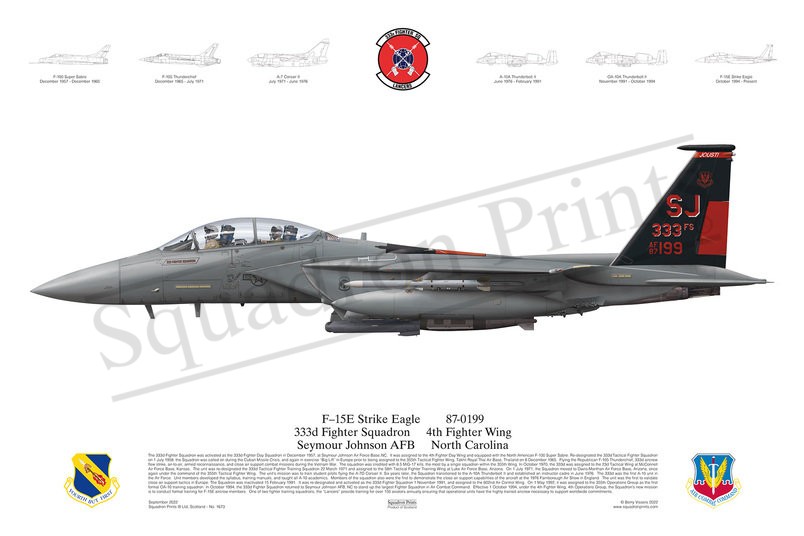#1673 333 FS F-15E Strike Eagle print

Description
Squadron Prints Lithograph No 1673 - 87-0119 '333 FS', F-15E Strike Eagle, 333rd Fighter Squadron, 4th Fighter Wing, Seymour Johnson AFB, North Carolina.
The 333d Fighter Squadron was activated as the 333d Fighter Day Squadron in December 1957, at Seymour Johnson Air Force Base, NC. It was assigned to the 4th Fighter Day Wing and equipped with the North American F-100 Super Sabre. Re-designated the 333d Tactical Fighter Squadron on 1 July 1958, the Squadron was called on during the Cuban Missile Crisis, and again in exercise “Big Lift” in Europe prior to being assigned to the 355th Tactical Fighter Wing, Takhli Royal Thai Air Base, Thailand on 8 December 1965. Flying the Republican F-105 Thunderchief, 333d aircrew flew strike, air-to-air, armed reconnaissance, and close air support combat missions during the Vietnam War. The squadron was credited with 6.5 MiG-17 kills, the most by a single squadron within the 355th Wing. In October 1970, the 333d was assigned to the 23d Tactical Wing at McConnell Air Force Base, Kansas. The unit was re-designated the 333d Tactical Fighter Training Squadron 22 March 1971 and assigned to the 58th Tactical Fighter Training Wing at Luke Air Force Base, Arizona. On 1 July 1971, the Squadron moved to Davis-Monthan Air Force Base, Arizona, once again under the command of the 355th Tactical Fighter Wing. The unit’s mission was to train student pilots flying the A-7D Corsair II. Six years later, the Squadron transitioned to the A-10A Thunderbolt II and established an instructor cadre in June 1976. The 333d was the first A-10 unit in the Air Force. Unit members developed the syllabus, training manuals, and taught all A-10 academics. Members of the squadron also were the first to demonstrate the close air support capabilities of the aircraft at the 1976 Farnborough Air Show in England. The unit was the first to validate close air support tactics in Europe. The Squadron was inactivated 15 February 1991. It was re-designated and activated as the 333d Fighter Squadron 1 November 1991, and assigned to the 602nd Air Control Wing. On 1 May 1992, it was assigned to the 355th Operations Group as the first formal OA-10 training squadron. In October 1994, the 333d Fighter Squadron returned to Seymour Johnson AFB, NC to stand up the largest Fighter Squadron in Air Combat Command. Effective 1 October 1994, under the 4th Fighter Wing, 4th Operations Group, the Squadron’s new mission is to conduct formal training for F-15E aircrew members. One of two fighter training squadrons, the “Lancers” provide training for over 150 aviators annually ensuring that operational units have the highly trained aircrew necessary to support worldwide commitments.
You may also like
-
Typhoon FGR4
VZ485 'L'; XH707 'T'; XP700 'A'; ZE965 'HA'; WM223 'U'; WT588 'P'; XT863 '014'; ZK342 'ED'892 Sqn; 6 Sqn; 43 Sqn; 222 Sqn; 23 Sqn; 74 Sqn; 151 SqnRAF Leuchars -
Harrier GR1, GR3, GR5, GR7 & GR9
XW917; XZ965; ZD407; ZG503; ZD356; ZG5303 SqnRAF Cottesmore -
C-141B Starlifter
66-0128728 MAS, 445 MAW; 729 MAS, 445 MAW; 730 MAS, 445 MAWNorton AFB, California
